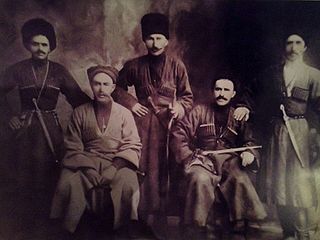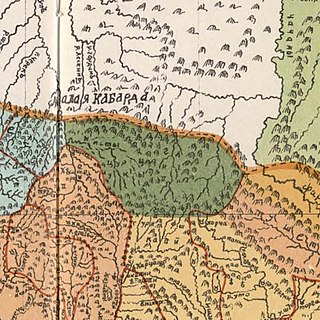Related Research Articles

Nazran is the largest city in Ingushetia, Russia. It served as the republic's capital from 1991 to 2000, until it was replaced by Magas, which was built for this purpose. It is the most populous city in the republic: 122,350 (2021 Census); 93,335 (2010 Census); 125,066 (2002 Census); 18,246 (1989 Soviet census).
Ingush, historically known as Durdzuks, Gligvi and Kists, are a Northeast Caucasian ethnic group mainly inhabiting the Republic of Ingushetia in central Caucasus, but also inhabitanting Prigorodny District and town of Vladikavkaz of modern day North-Ossetia. The Ingush are predominantly Sunni Muslims and speak the Ingush language.

The Orstkhoy, historically commonly known under their exonyms: Karabulaks, Balsu, Baloy, are a historical ethnoterritorial society among the Chechen and Ingush peoples. Their homeland is in the upper reaches of the Assa and Fortanga rivers in the historical region of Orstkhoy-Mokhk. In the tradition of the Chechen ethno-hierarchy, it is considered one of the nine historical Chechen tukkhums, in the Ingush tradition as one of the seven historical Ingush shahars.

Simsim was either a historical region or kingdom in the North Caucasus during the Middle Ages, existing in the 14th century. Predominantly localized roughly in eastern Chechnya (Ichkeria), with some also connecting part of Kumyk Plain. Simsim is also localized in both Chechnya and Ingushetia. Its name may have been derived from the Chechen village of Simsir. However, according to folklore, the King Gayur-khan was chosen as the leader of all Chechens by the Mehk-Khel. In its later years it allied itself with the Golden Horde before being destroyed in 1395 by Timurlane, which was recorded in Zafarnama by Nizam al-Din Shami and the Zafarnama by Sharaf ad-Din Ali Yazdi.

The Feappii were an Ingush subgroup (society) that mostly inhabited the mountainous Fappi region of Ingushetia in the Caucasus. Historically, they bordered on the west with Dzherakh, on the east with Khamkhins, on the north with Nazranians, and in the south with Gudomakarians. The center of the society was the fortified village (aul) of Erzi or Metskhal.

Fappi or Fappi mokhk, exonym: Kistetia, is a historical region in Ingushetia. Fappi is the territory of historical settlement of the Fyappiy society.

The Nazranians were a historical Ingush ethnoterritorial subethnic group (society) which inhabited modern day Nazranovsky District and Prigorodny District.

Kists or Kistins is an old exonym of all Nakh peoples, under which local societies later were designated, and conditionally divided into nearby Kistins and distant Kistins. In Russian sources of the 19th century, the term nearby Kistins referred to the inhabitants of the Kistin Gorge in the vicinity of river Armkhi, and distant Kistins referred to the inhabitants of the upper reaches of the Argun. Today the name is mostly used to refer to the Chechens who compactly live in the Pankisi Gorge of Georgia.

The Dzherakh, also spelled Jerakh, historically also known as Erokhan people, were a historical Ingush ethnoterritorial society, today a tribal organization/clan (teip), that was formed in the Dzheyrakhin gorge, as well as in the area of the lower reaches of the Armkhi River and the upper reaches of the Terek River.

Torshkhoy, also known in Ingush folklore as Them-Thoarshkhoy, is an Ingush clan (teip) which belongs to the Fyappin society. The ancestral auls of Torshkhoy are Tyarsh and Falkhan. A small number of representatives of the teip live in Aukh, where they are known under the name Vyappiy.

Tsori a rural locality in Dzheyrakhsky District of Ingushetia. It is part of the Guli rural settlement.

Tsorins, Tsori, also Ghalghaï, were a historical Ingush ethnoterritorial society that was located in mountainous Ingushetia in the region of river Guloykhi. The center of the society was Tsori from which it got its name. Tsorin society, like the Khamkhin society, was formed from the former "Galgaï society" as a result of the transfer (appearance) of rural government to the village Tsori.
Arshty is a rural locality in Sunzhensky District of the Republic of Ingushetia, Russia, located on left bank of the river Arshtynka near the border with the Republic of Chechnya. It forms the municipality of the rural settlement of Arshty as the only settlement in its composition.

Ingush okrug was a district (okrug) of the Terek Oblast of the Caucasus Viceroyalty of the Russian Empire. The area of the Ingushskiy okrug made up part of the North Caucasian Federal District of Russia.
Khay is a non-residential rural locality in Achkhoy-Martanovsky District of the Republic of Chechnya, Russia.

Meredzhi is a non-residential rural locality in Galanchozhsky District of the Republic of Chechnya, Russia.

Metskhal is an abandoned aul in the Dzheyrakhsky District of Ingushetia. It is part of the rural settlement of Lyazhgi.
Gandalbos is rural locality in Sunzhensky District of the Republic of Ingushetia, Russia, located on the left bank of the river Fortanga. It is part of the municipality of the rural settlement of Dattykh.
Gorsky Uchastok was a territorial-administrative unit (uchastok) of the Ingushskiy Okrug of the Terek Oblast of the Russian Empire. The area of the Gorsky Uchastok made up Dzheyrakhsky and part of the Sunzhensky Districts of Ingushetia.

Veappii is a Chechen clan (teip) of the Aukhs, which inhabits Aukh, a region in modern-day Dagestan. The cultural center of the Veappii was Erzi, located in Ingushetia. During the 17th and 18th centuries, they migrated from Ingushetia to Aukh. According to their teptar, they originated from the mountainous aul of Tyarsh. The Veappii were renowned for their skills as blacksmiths and craftsmen. Veappii speak the Pkharchoi dialect of the Aukh dialect of the Chechen language.
References
- ↑ Албогачиева 2015, p. 177 (10 as PDF).
- ↑ Албогачиева, Мартазанов & Соловьева 2013, p. 177.
- ↑ Албогачиева 2015, p. 177.
- ↑ Доклад о границах и территории Ингушетии 2021 , p. 8 (referring to Перечневая ведомость о числительном состоянии народонаселения в Карабулакском участке на 1864 г. Сост. 4 февраля 1865 г. / ЦГА РСО-А. Ф. 26. Оп. I. Д. 33.).
- ↑ Доклад о границах и территории Ингушетии 2021 , p. 8 (referring to Перечневая ведомость о числительном состоянии народонаселения в Карабулакском участке на 1864 г. Сост. 4 февраля 1865 г. / ЦГА РСО-А. Ф. 26. Оп. I. Д. 33.).